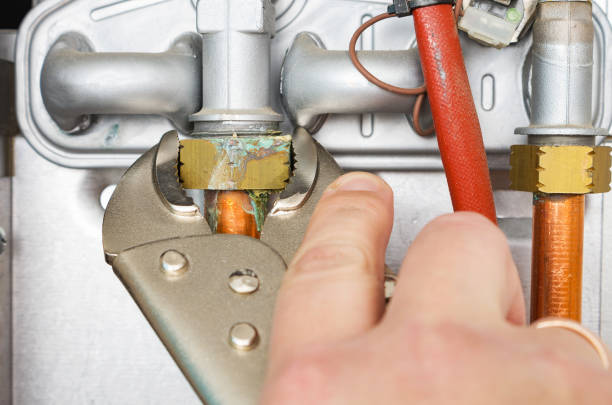Combi boilers are a popular choice for home heating and hot water for many reasons, but leaks can still occur. Adding leak sealer could be the answer you’re looking for. Leak sealer is a type of product that helps to fix small leaks in your combi boiler and heating system. Keep reading to learn more about how you can add leak sealer to your combi boiler.
In this article, we’ll guide you through the process of adding leak sealer to your combi boiler, including the tools and products you’ll need.
Steps to add leak sealer:
- Step 1: Gather Your Tools
- Step 2: Turn Off Your Combi Boiler and let it cool
- Step 3: Locate the Leak
- Step 4: Clean the area
- Step 5: Apply the Leak Sealer according to manufacturer’s instructions

How to Add Leak Sealer to Your Combi Boiler
Step 1: Gather Your Tools
Before you begin, you’ll need to gather the following tools and products, The following tools are needed:
- Leak sealer specifically designed for combi boilers – This is an essential component for fixing leaks in your combi boiler. Make sure to purchase a product that is specifically designed for this type of boiler.
- Gloves to protect your hands – The leak sealer can be harmful if it comes into contact with your skin, so it is important to wear gloves to protect your hands.
- A clean cloth – A clean cloth is needed to clean the area around the leak before applying the sealer.
- A bucket – A bucket is required to catch any excess leak sealer that may drip while you are working on your boiler.
Step 2: Turn Off Your Combi Boiler and let it cool
The first step in adding leak sealer to your combi boiler is to turn off the power supply. This will prevent any electrical accidents from occurring while you are working on your boiler.
It is important to follow the manufacturer’s instructions for turning off your combi boiler, as the process may vary depending on the model. Follow safe isolation procedures.
Step 3: Locate the Leak
Once your combi boiler is turned off, you’ll need to locate the leak. This may require some investigating, but the most common places for leaks in a combi boiler are the pipes and the joints.
If you are having difficulty finding the leak, you may want to turn the boiler back on and monitor the area for any dripping or dripping noises.
Step 4: Clean the area
Once you’ve found the leak, use a clean cloth to clean the area around the leak. This will help ensure that the leak sealer adheres properly. Make sure to clean the area thoroughly, removing any dirt or debris that may interfere with the adhesion of the leak sealer.
Step 5: Apply the Leak Sealer
Disclosure: Some of the links below are Amazon affiliate links. This means that, at no cost to you, we may earn an affiliate commission if you click through the link and complete a purchase.
Now it’s time to add the leak sealer to your combi boiler. Follow the instructions on the product carefully. There are different types of leak sealers and methods.
Commonly, the leak sealer will be applied or poured directly into the leak and then allowed to sit for the recommended amount of time before being wiped away with a clean cloth.
If there is any excess leak sealer, catch it in the bucket so that it doesn’t drip onto the floor.
Method 1: Direct Application Method
The Direct Application Method is best used for small leaks in accessible areas of the boiler. This method involves applying the leak sealer directly to the leak using a brush or a pour spout.
To ensure safety, turn off the power supply to the boiler before beginning the process. Make sure to wear gloves to protect your hands and follow the manufacturer’s instructions for the leak sealer. Apply the sealer to the leak, let it dry, and turn the power back on.
Method 2: Injection Method
The Injection Method is used for larger leaks or leaks that are not easily accessible. In this method, the leak sealer is injected into the boiler system through the system’s filling loop or a radiator air vent.
An adaptor is usually included with the product to help insert the leak sealer into the system. Before beginning, turn off the power supply to the boiler and make sure to wear gloves.
Follow the manufacturer’s instructions for the injector tool and leak sealer. Inject the sealer into the system, let it circulate, and turn the power back on.
Central heating leak sealer can take anywhere from a few minutes to a few hours to take effect. The time it takes to take effect depends on the type of sealant used and the size and location of the leak. Most products usually take up to 24 hours for full effect.
It is possible to apply leak sealer through the magnetic filter in a combi boiler, but it is not recommended. The magnetic filter is designed to remove any iron oxide and other debris from the system, and adding leak sealer through it may clog the filter and cause additional problems.
Step 6: Test for Leaks
After the leak sealer has been applied and allowed to sit for the recommended amount of time, turn your combi boiler back on and test for leaks. Check the area around the leak for any dripping or dripping noises, and also check for any leaks in other parts of the boiler.
If there are still leaks present, you may need to repeat the process or call a professional for assistance.

What Are the Benefits of Adding Leak Sealer?
Adding leak sealer to your combi boiler comes with a number of benefits. The most obvious benefit is that it can help fix a leak. Additionally, leak sealers are typically affordable, easy to use, and can be used on a variety of materials, such as copper and steel.
Does leak sealer damage the boiler?
Leak sealer should not damage a combi boiler when used properly. Leak sealers are specifically designed to be used with boilers and are formulated to be safe and effective. They shouldn’t cause any blockages either.
In some cases, using leak sealer can also mask a larger problem that needs to be addressed, so it is important to have a professional assess the situation if you are unsure about the cause of the leak.
Disadvantages of using leak sealer in a combi boiler
- If not using the correct type, a leak sealer can block pipes and prevent proper water flow, leading to reduced efficiency and effectiveness of the boiler system.
- Leak sealer may not completely patch up the leak and the issue may recur.
- Overuse of leak sealer may cause additional corrosion in the pipes, leading to further damage to the system.
- Leak sealer may not be compatible with all types of combi boiler systems, resulting in further complications.
- Improper use of leak sealer may cause further damage to the system, leading to costly repairs.
Summary
Adding leak sealer to your combi boiler can help to fix a leak and prevent further damage. This guide has outlined the steps to add leak sealer to your combi boiler and the benefits it can provide. If you have any other questions about adding leak sealer to your combi boiler, be sure to consult a professional for help.
Related articles:

